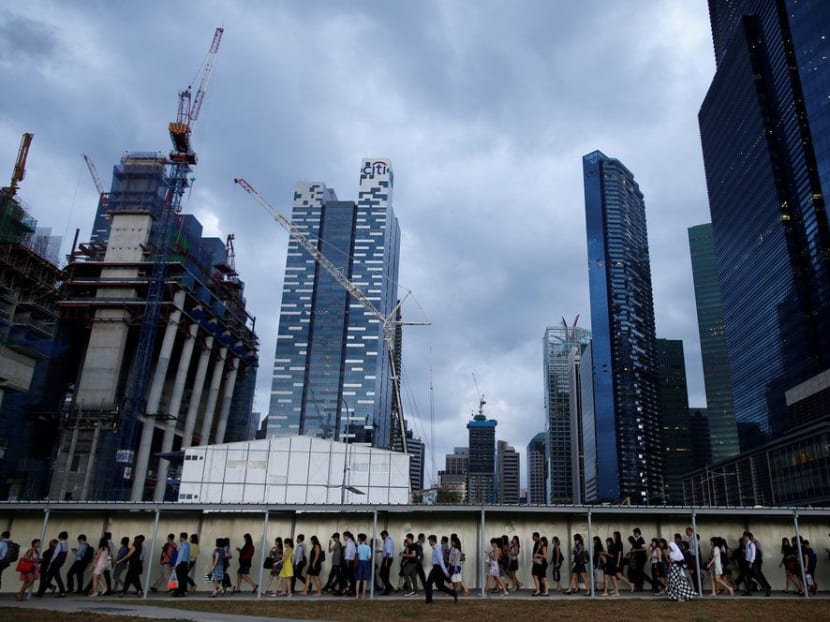What you need to know about MOM’s latest labour report
SINGAPORE — The latest annual labour market report released on Thursday (Nov 29) by the Ministry of Manpower (MOM) painted an overall positive picture, with main indicators such as the employment rate and real median income on the rise.
SINGAPORE — The latest annual report on the labour market by the Ministry of Manpower (MOM) painted an overall positive picture, with main indicators such as the employment rate and real median income on the rise.
For example, a greater proportion of the population are employed, with 65.1 per cent working as of June, compared to 64.9 per cent a year ago.
Wage growth is also outstripping inflation, with the real median income growing by 3.5 per cent every year for the last five years. This is higher than the 1.9 per cent wage growth per year over the previous five years. Including employers’ contributions to the Central Provident Fund (CPF), the median gross monthly income as of June was S$4,437, compared to S$3,705 in June 2013 and S$2,897 in June 2008.
The report, released on Thursday (Nov 29), was based on MOM’s Comprehensive Labour Force Survey done in the middle of this year among Singaporeans and permanent residents. In particular, three things caught the eye:
1. Rise in percentage of workers on fixed-term contracts
Between last June and this June, the proportion of workers in permanent jobs dipped from 90.1 per cent to 89.4 per cent. Conversely, the proportion of those on fixed-term contracts went up from 6.4 per cent to 7.2 per cent over the same time period. As for casual workers hired on ad-hoc basis, the figure fell marginally from 3.5 per cent to 3.4 per cent.
The MOM report said that companies are more cautious with the economy undergoing restructuring, and they prefer hiring workers on a more short-term basis.
Analysts told TODAY such a trend is set to continue as the gig economy grows. Recruitment firm Adecco Singapore's country manager Mark Hall expects the proportion of workers on fixed-term contracts to grow up to 10 per cent in the next three to five years.
The flexibility that comes with the gig economy, however, is a double-edged sword. Economic lecturer Kelvin Seah from the National University of Singapore said that there will be “lower employment security and less stable earnings” for such workers.
Mr Hall said that there is a way out. Instead of tying labour and social policies to employment or employers, it can be made “individual, portable and transferable”, and this will enhance social security.
2. Faster wage growth for lower-income workers
The wage gap between the lower-income and median-income workers has narrowed partly due to a tighter labour market, as the foreign workforce policy was made more stringent.
The real income of the lowest 20th percentile grew 4.2 per cent annually over the last five years, faster than the 3.5 per cent growth for the median worker.
The bottom 20 per cent are earning S$2,340 a month including CPF contributions from their employers. That is 52.7 per cent the wage of a median worker.
In comparison, the bottom 20 per cent earned S$1,885 in 2013, which was 50.9 per cent of what the median worker earned monthly.
A faster wage growth among the poor, while good news, “does not necessarily mean that inequality in society would decline”, Mr Seah noted, as that would depend on the wage growth of the highest-income earners.
The MOM report did not provide the monthly income of the top 20th percentile of earners.
Based on a 2017 household income report by the Department of Statistics, the bottom 20th percentile experienced a 2.1 to 2.8 per cent growth in average household income for each member, while the increase for the top 20th percentile was between 2.6 per cent and 4.5 per cent.
3. Higher “time-related underemployment” rate
Underemployment occurs when highly skilled workers take on low-paying or low-skilled jobs, as well as when workers willing to put in extra hours involuntarily work part-time.
The MOM uses a “time-related underemployment” indicator, which measures the proportion of part-time resident workers who want to work more.
In the latest report, the proportion rose for the second successive year from 3 per cent last year to 3.3 per cent this year, after a general downtrend from 2011.
But the MOM pointed out that there was “no evidence of an increase in involuntary time-related underemployment”. The rise came mainly from persons who were engaging in part-time work because of family or personal responsibilities (0.9 per cent in 2017, 1.4 per cent in 2018).
At the same time, the proportion of part-timers who wanted to work more hours but could not find a full-time job was largely the same (1.1 per cent in 2017, and 1 per cent in 2018).
The report also found that among those who are looking to enter the labour force, 39 per cent of them preferred to work part-time. “Preference for part-time employment was higher among older potential entrants aged 60 and over and females in their 50s,” the report said.









